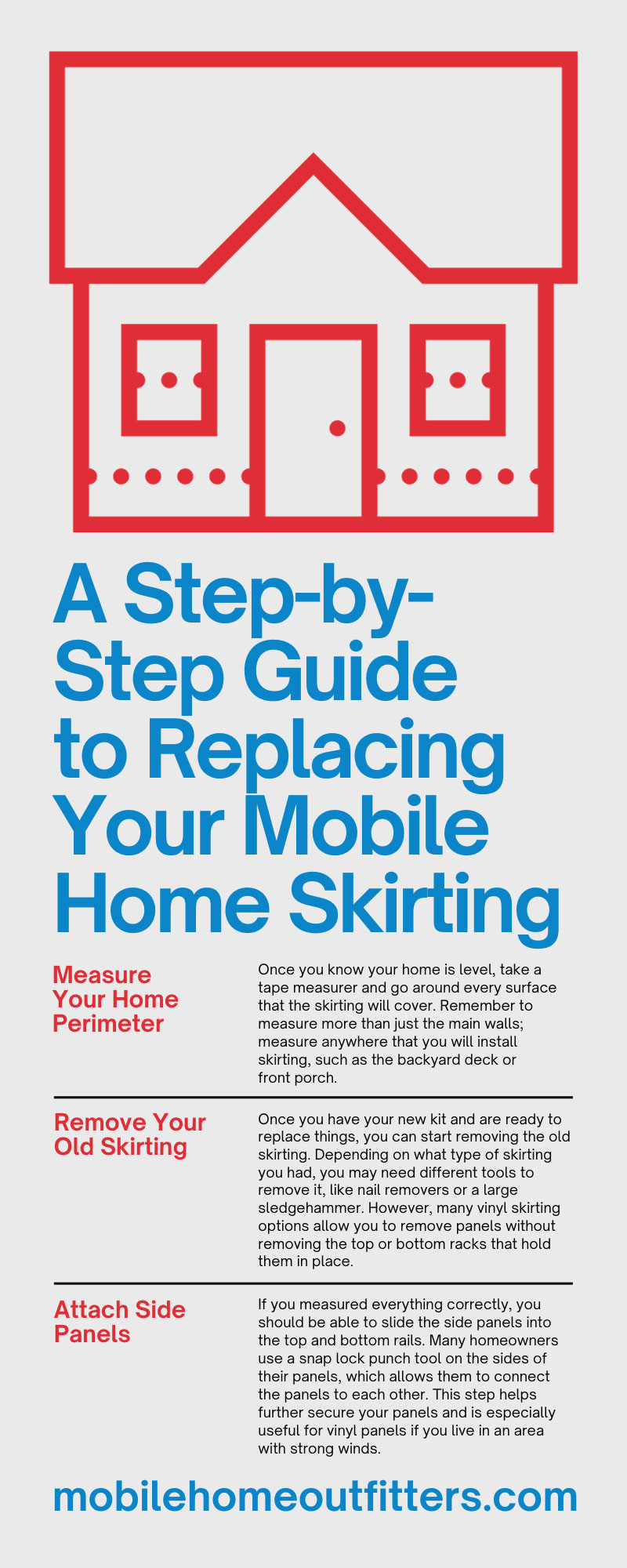
Mobile home skirting is a fundamental part of any manufactured home. Skirting is a layer of vinyl, metal, brick, or wood that goes around the perimeter of your home and protects the underside. Due to the basic construction of mobile homes, skirting helps protect the pipes and crawlspace from wild animals, adverse weather conditions, and other dangers that could result in costly repairs.
Because of this important task, skirting often takes some wear and tear of its own and needs replacing after some time. Maybe that time is here, or you just want to upgrade your skirting to something that looks a bit flashier. Either way, here’s a step-by-step guide to replacing your mobile home skirting, brought to you by Mobile Home Outfitters.
The process entails quite a few steps, but you’ll find it a fairly straightforward process with a bit of careful planning. Replacing skirting is a task many homeowners do themselves, so you may not need to hire a contractor to help if you can stay on top of things.
1. Measure Your Home Perimeter
The first thing you need to do is get an exact measurement of your home. You want to ensure your mobile home is on level ground. If it’s not, releveling your home should be your top priority before replacing the skirting.
Once you know your home is level, take a tape measurer and go around every surface that the skirting will cover. Remember to measure more than just the main walls; measure anywhere that you will install skirting, such as the backyard deck or front porch.
You should also note the height of your skirting from the bottom of your mobile home to the ground. Many people measure the four corners of their house and then the middle of the front and back. You can add these heights together and then divide by six to get what we call the average height.
2. Get Your Kit
Before you can install new skirting, you need to get a kit. Thankfully, this step is much easier once you have the proper measurements. One option homeowners have is to take the measurements down to a hardware store or other shop that specializes in such things. Alternatively, you can use the online skirting calculator from Mobile Home Outfitters. You just type in your measurements, and we help you find the right size and style of skirting kit to meet your needs.
3. Remove Your Old Skirting
Once you have your new kit and are ready to replace things, you can start removing the old skirting. Depending on what type of skirting you had, you may need different tools to remove it, like nail removers or a large sledgehammer. However, many vinyl skirting options allow you to remove panels without removing the top or bottom racks that hold them in place.
4. Install the Bottom Rail
The bottom rail, sometimes known as the U-channel, is the bottom part of the kit that usually has space for panels to lock into place. You want to take special precautions to install this properly, or else the rest of your skirting will be crooked and off-center. We recommend starting from one of the corners and anchoring the rail with a ground spike after you know you aligned it properly.
5. Affix the Top Rail
The top rail attaches directly to the underside of your mobile home and goes around the perimeter, similar to the bottom rail. Much like with the bottom rail, we recommend starting from the corner and ensuring you have it lined up properly to avoid loose or crooked panels.
Because certain skirting materials like wood may grow or shrink depending on weather conditions, leave some extra space with the top rail to avoid future damage to your panels. You might consider not fastening the top rail as tight as the U-channel in case you need to make adjustments later.
6. Attach Side Panels
The side panels are the most significant part of your skirting, as these are the parts that offer the most protection. Depending on the kit you ordered, you should have either precut panels or one large piece that you need to cut into different sections. If you do need to cut the pieces yourself, you can use one of the old panels you removed from your house as a measurement.
If you measured everything correctly, you should be able to slide the side panels into the top and bottom rails. Many homeowners use a snap lock punch tool on the sides of their panels, which allows them to connect the panels to each other. This step helps further secure your panels and is especially useful for vinyl panels if you live in an area with strong winds.
7. Attach Corner Pieces
Once everything else seems to be in place, you can attach the corner pieces. You want to bend these segments without breaking them, and then slide them between the rails. When measuring the corner pieces, you should use the measurements from the edges of the panels where they meet in the corner. The corner piece should have a slight overlap with the side panels that you can use to attach it and ensure there aren’t any cracks or gaps.
8. Add Final Touches
Now that everything is done, you should check for anything that seems out of place. If you have some overlapping panels, you may need to remove them and give them a slight trim. Likewise, if you notice any space between panels, you may want to reinstall a few panels to see if you can remove the gaps.
Now that you’ve followed this step-by-step guide to replacing your mobile home skirting, you should be good to go! Remember that you can get your manufactured home skirting kits custom-made for your home measurements by using the online skirting calculator from Mobile Home Outfitters. If you have any additional questions or concerns about the process, please don’t hesitate to contact us anytime, and we’ll be happy to assist you!


